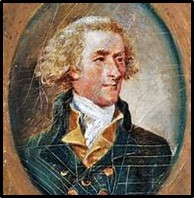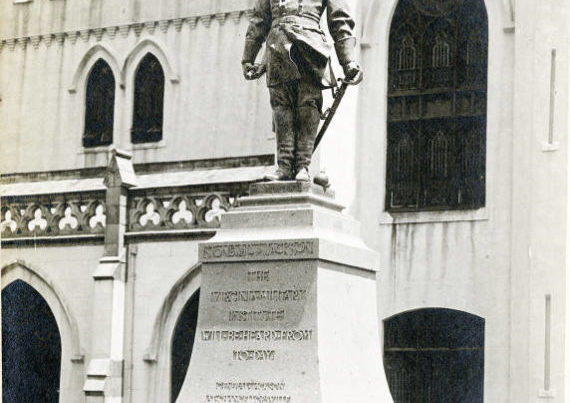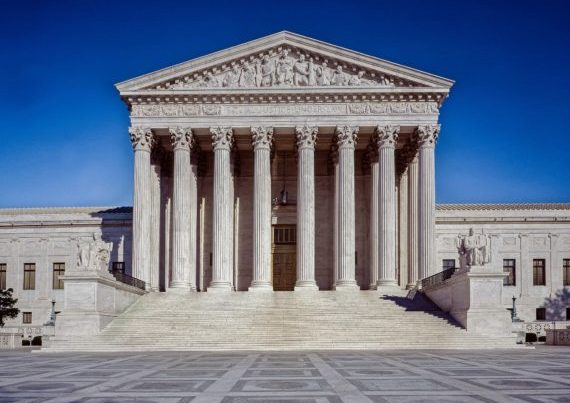With the election of Rutherford B. Hayes by a one vote margin in the Electoral College, the Compromise of 1877 ended the era of Reconstruction in the minds of the people. As Southern States were re-admitted into the Union, Federal troops stood down or returned to the North. From about 1885 to 1924, before and after the 50th Anniversary of the War Between the States, there was a great sense of need for the spirit of forgiveness and reunification and remembrance of the greatest war Americans ever fought and hopefully ever will. There was a great desire for conciliation and honor for those now aging and to those who had perished on the battlefields. This was also the America Beautiful period in our history in which parks, public spaces, sculpture, urban landscaping and rebuilding was going on across the nation with a positive sense of making life more livable, civil and cultured.
The venerable Grand Old Army and the Confederate Veterans of America held conventions, where tales were swapped of valor, loss, glory and honor. Reunions held at battlefields, staged mock engagements – joining together North and South, to relive their past, break bread with their comrades and former enemies, and extend hands of forgiveness, reconciliation and respect between Veterans now gray bearded and wizened. It was during this time that both North and South erected their monuments and memorials to their war heroes, leaders, comrades, and to the many that had fallen in the field of battle, whom they and their families and friends respectfully remembered.
The sculptures of North and South, of course, glorified their individual side’s distinct messages, which acted as eternal symbols to their causes and their glory, to express bits of momentary history. Those actors on this stage of time, would hopefully live on in the minds of posterity, and the history of theirs and the nation’s struggles would not be forgotten, nor would their lives be counted as squandered and wasted in vain, as sands falling through an hour glass. Rather, it was intended, that these men and events should be reflected on into the future and contemplated and argued about and reflected upon, as actors of a grand play of immortal history, continuing to be studied and remembered through the ages. Their purpose was to give meaning to heroism, bravery, honor, commitment, patriotism and duty.
The Great War had been a grand epic tragedy in which the glories of the past could positively shape or constrain our future, but should remind us all, of the faults and failures of all mankind and also his nobility. These events and monuments both in the North and South, today serve as a guiding light to direct future generations of Americans. These monuments, all, are the greatest sculptural assets of our nation, created at the zenith or our cultural history. No one monument can define this era in time, any more than a single actor or a single scene can define a play. No more than the First Battle of Manassas could define four years of endless carnage, blood, sorrow, glory and defeat. America’s historic monuments are our heritage, the complete play, warts and all… the story of America’s great defining epoch. But, it is not just our story. It is a story for the world.
Current events in America have metastasized from what was an ambivalent era of political correctness, into what is very quickly becoming a Maoist Cultural Revolution. As the world leader, America’s actions, attitudes and fashions are followed copied and mimicked everywhere on the globe, whether they are innovative, wholesome or obscene. Recently, what extremist and terrorist have done in the Middle East, in the name of iconoclasm, is repugnant and a crime against humanity, world history and art. In the past what did occur in the secret world of Eastern socialism was spurned by the West as shameful. But today, somehow the vector of this madness has infected our nation nearly fifty years later, like an Asian flu. But, from American shores this viral pathogen could become a global contagion that will consume the world’s historic culture and its symbols of heritage and civility. Americans should not encourage or promote an image of acceptability of a diseased influence that will only diminish our nation’s power, prestige and honor and encourage international chaos and undermine world culture and beauty. We should act more civilized and mature than that. We have a global leadership responsibility to promote the values of our constituted and inalienable protected rights of speech, writing, assembly and expression. When America constrains these rights, by censorship in whatever form, she does so at her own peril. The fall of Rome did not happen on one day. All of America’s historic monuments are the visual representations of our American History.
 Contemplate for a moment two great works of American sculpture, one honoring Gen. Thomas “Stonewall” Jackson, CSA and the other Gen. William Tecumseh Sherman, USA. The American sculptors of these two great works of equestrian martial art, Charles Keck and Agustus Saint-Gaudens were both members of the National Sculptor Society. Saint-Guadens along with the architect Stanford White formed the Society and also the American Academy in Rome. Both statues employ angels. Saint-Guadens also depicted, an angel, as a last addition, in his most famous work “Shaw and the 54th Colored Troops”. In the monument to Sherman his female angel is on the statue itself as a full figure. She holds a branch of laurel, a sign of victory, out in front of her like a guiding light to Sherman. In his Shaw his angel is far more quizzical, (Shaw and his men were largely slaughtered in their attempt to take Fort Wagner outside of Charleston). The Sherman angel is hinged off a sloping ground plain which gives her a feeling of suspension and her wings and chitin are blown back by the wind going past her forward motion. Likewise Sherman’s cape is billowed back implying his forward motion, while his posture is erect and easy, as his horse is in a canter, all signs of surety and composure in victory.
Contemplate for a moment two great works of American sculpture, one honoring Gen. Thomas “Stonewall” Jackson, CSA and the other Gen. William Tecumseh Sherman, USA. The American sculptors of these two great works of equestrian martial art, Charles Keck and Agustus Saint-Gaudens were both members of the National Sculptor Society. Saint-Guadens along with the architect Stanford White formed the Society and also the American Academy in Rome. Both statues employ angels. Saint-Guadens also depicted, an angel, as a last addition, in his most famous work “Shaw and the 54th Colored Troops”. In the monument to Sherman his female angel is on the statue itself as a full figure. She holds a branch of laurel, a sign of victory, out in front of her like a guiding light to Sherman. In his Shaw his angel is far more quizzical, (Shaw and his men were largely slaughtered in their attempt to take Fort Wagner outside of Charleston). The Sherman angel is hinged off a sloping ground plain which gives her a feeling of suspension and her wings and chitin are blown back by the wind going past her forward motion. Likewise Sherman’s cape is billowed back implying his forward motion, while his posture is erect and easy, as his horse is in a canter, all signs of surety and composure in victory.
 Keck also has an angel in his statue of Jackson, but it is carved into the base, its wings thrown back in defensive protection of the Southern ground. The male angel bears his breast and defiantly exposes himself to danger, thrusting out his bosom in bravery to the wind. He carries a shield with the cross of St. Andrew of the Confederacy to likewise defend the Southern land from aggression. Above, the sculpture of Jackson is mounted on a small war horse, which is held back at a trot by Jackson (Jackson did not like to ride and, in fact, preferred smaller horses. Sherman is mounted on a tall and impressive dress horse). Jackson’s figure shows agility and action and Jackson’s gaze is one of decisiveness and determination, and he holds the reins as his horse tilts his head implying that Jackson is about to make a decisive turn. Saint-Gauden’s Sherman is gilded and elevates Sherman to the level of the Gods and his angel is his guide. Whereas the angel of Keck’s Jackson is fixed firmly on the sacred ground he defends as a common man with angelic aid.
Keck also has an angel in his statue of Jackson, but it is carved into the base, its wings thrown back in defensive protection of the Southern ground. The male angel bears his breast and defiantly exposes himself to danger, thrusting out his bosom in bravery to the wind. He carries a shield with the cross of St. Andrew of the Confederacy to likewise defend the Southern land from aggression. Above, the sculpture of Jackson is mounted on a small war horse, which is held back at a trot by Jackson (Jackson did not like to ride and, in fact, preferred smaller horses. Sherman is mounted on a tall and impressive dress horse). Jackson’s figure shows agility and action and Jackson’s gaze is one of decisiveness and determination, and he holds the reins as his horse tilts his head implying that Jackson is about to make a decisive turn. Saint-Gauden’s Sherman is gilded and elevates Sherman to the level of the Gods and his angel is his guide. Whereas the angel of Keck’s Jackson is fixed firmly on the sacred ground he defends as a common man with angelic aid.
Both of these great American monuments, to mortal men and great martial events, portray a story of defense and valor, victory and defeat, but above all they are symbolic artistic representations of our nation’s rich historical past, left to us all, by our forefathers, for ourselves and generations to follow, to reflect upon into the future.





